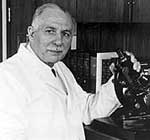Born in Buffalo, New York in 1903, Sidney Farber grew up the third eldest of fourteen children. After graduating from the University of Rochester in 1923, he began his first year of Medical School at the Universities of Heidelburg and Freiburg in Germany. Following one year in Germany, Farber transferred to Harvard Medical School in Boston, where he graduated in 1927. Farber remained in Boston, and after completing graduate work in pathology under mentor Kenneth Blackfan at the Peter Bent Brigham Hospital, Farber was offered a position as resident pathologist at Children's Hospital, where he became the first full-time pathologist in 1929. He also became an assistant in pathology at Harvard Medical School in 1928. At Harvard Medical School and Children's Hospital, Farber established programs of teaching and research which were focused on childhood disorders.

Dr. Farber, at 66
years old
While working at Harvard Medical School, Farber became known as the 'father' of the modern era of chemotherapy of neo-plastic disease, as well as the 'father' of modern pediatric pathology with his extensive research work. Leukemia at the time was thought to be a death sentence. However, Farber was persistent in finding a cure for this disease. Because leukemia is a disease of the white blood cell-making tissue of the bone marrow, Farber knew that if he could find a drug to chemically block folic acid (which stimulates growth of the bone marrow), it could stop the production of the bad bone marrow which causes the disease. It was at Harvard Medical School where Farber completed a preclinical and clinical evaluation of aminopterin, a "foliate antagonist in childhood acute lymphoblastic leukemia." Out of 16 children used in the experiment, 10 went into remission. These trials showed for the first time that induction of hemotalogical and clinical remission in leukemia was possible. Leukemia was not necessarily a death sentence.

Dr. Farber with a
young patient
The results of Farber's trial were reported in a June 3, 1948 issue of the New England Journal of Medicine and were met with mixed reviews. Researchers were wary of the findings which they had worked long to discover. However, practicing physicians and pediatricians praised the new findings. The publication of Farber's results also caught the eye of the Variety Club of New England, a charitable organization looking to invest in a promising venture. The club approached Farber and established the Children's Cancer Research Foundation, as well as funded an outpatient clinic at Children's Hospital which Farber had started. The foundation had an unforgettable night on May 22, 1948 when one of it's patients being treated at the clinic, whom for privacy Farber named "Jimmy" appeared on the radio show "Truth or Consequences." As a result of the show, the foundation received $250,000 in donations, which helped to create the construction of the Jimmy Fund building in Boston, which opened in 1952 and contained state-of-the-art laboratories and equipment. This organization would later would later become the Sidney Farber Cancer Institute.
At the Institute, Farber was well-liked and started many practices which are common in medical care nowadays. He commanded regular, daily contact between patients and social workers at the clinic, a practice unheard of in his day. Farber also came up with the idea of "total care," where all services for the patient and family, including counseling, nutrition, etc., where provided in one place.

Dr. Farber with his
equipment
Farber continued his work throughout the 1950s and 60s. In 1955, he discovered that the antibiotic actinomycin D and radiation therapy could produce remission in Wilms' tumor, a pediatric cancer in the kidneys. During this time period, Farber moved his work onto the national stage. He began appearing regularly before congress making appeals for more funds towards cancer research. As a result of his efforts, funding towards cancer research in one decade (1957-1967) went from $ 48 million to $ 176 million. He also worked to parlay his research and clinic with children into adult cancer research, and after being unsuccessful establishing one at Brigham and Women's Hospital, Farber opened an adult version of his inpatient clinic at Children's in his own Institution.
Farber continued his work until is death in 1973 of a heart attack, pushing to find a cure for cancer. After his death, the Sidney Farber Cancer Institute was renamed the Dana-Farber Cancer Institute, the name it holds to this day.